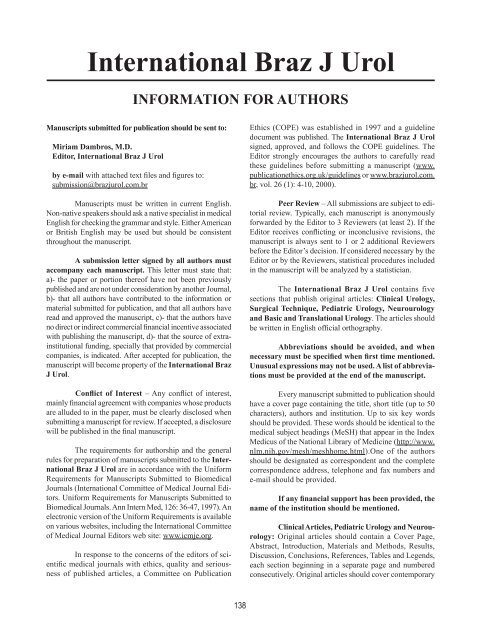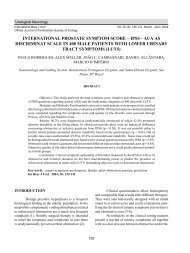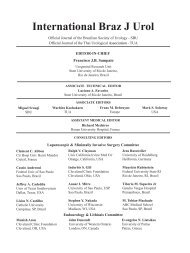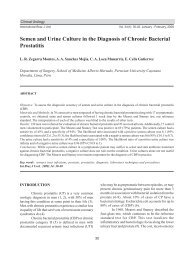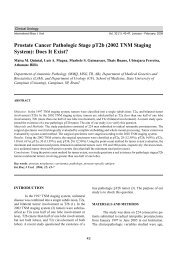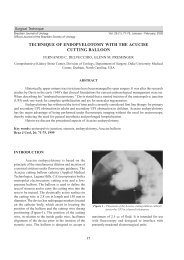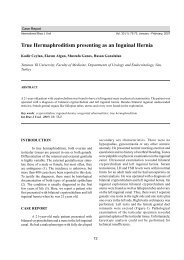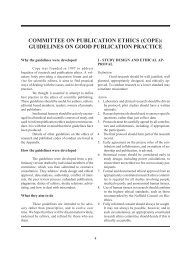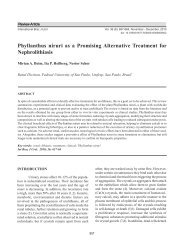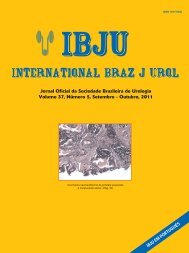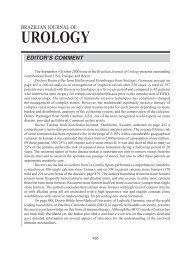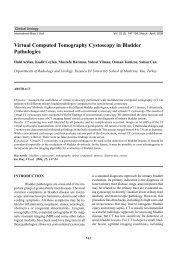International Braz J Urol
International Braz J Urol
International Braz J Urol
Create successful ePaper yourself
Turn your PDF publications into a flip-book with our unique Google optimized e-Paper software.
<strong>International</strong> <strong>Braz</strong> J <strong>Urol</strong><br />
INFORMATION FOR AUTHORS<br />
Manuscripts submitted for publication should be sent to:<br />
Miriam Dambros, M.D.<br />
Editor, <strong>International</strong> <strong>Braz</strong> J <strong>Urol</strong><br />
by e-mail with attached text files and figures to:<br />
submission@brazjurol.com.br<br />
Manuscripts must be written in current English.<br />
Non-native speakers should ask a native specialist in medical<br />
English for checking the grammar and style. Either American<br />
or British English may be used but should be consistent<br />
throughout the manuscript.<br />
A submission letter signed by all authors must<br />
accompany each manuscript. This letter must state that:<br />
a)- the paper or portion thereof have not been previously<br />
published and are not under consideration by another Journal,<br />
b)- that all authors have contributed to the information or<br />
material submitted for publication, and that all authors have<br />
read and approved the manuscript, c)- that the authors have<br />
no direct or indirect commercial financial incentive associated<br />
with publishing the manuscript, d)- that the source of extrainstitutional<br />
funding, specially that provided by commercial<br />
companies, is indicated. After accepted for publication, the<br />
manuscript will become property of the <strong>International</strong> <strong>Braz</strong><br />
J <strong>Urol</strong>.<br />
Conflict of Interest – Any conflict of interest,<br />
mainly financial agreement with companies whose products<br />
are alluded to in the paper, must be clearly disclosed when<br />
submitting a manuscript for review. If accepted, a disclosure<br />
will be published in the final manuscript.<br />
The requirements for authorship and the general<br />
rules for preparation of manuscripts submitted to the <strong>International</strong><br />
<strong>Braz</strong> J <strong>Urol</strong> are in accordance with the Uniform<br />
Requirements for Manuscripts Submitted to Biomedical<br />
Journals (<strong>International</strong> Committee of Medical Journal Editors.<br />
Uniform Requirements for Manuscripts Submitted to<br />
Biomedical Journals. Ann Intern Med, 126: 36-47, 1997). An<br />
electronic version of the Uniform Requirements is available<br />
on various websites, including the <strong>International</strong> Committee<br />
of Medical Journal Editors web site: www.icmje.org.<br />
In response to the concerns of the editors of scientific<br />
medical journals with ethics, quality and seriousness<br />
of published articles, a Committee on Publication<br />
Ethics (COPE) was established in 1997 and a guideline<br />
document was published. The <strong>International</strong> <strong>Braz</strong> J <strong>Urol</strong><br />
signed, approved, and follows the COPE guidelines. The<br />
Editor strongly encourages the authors to carefully read<br />
these guidelines before submitting a manuscript (www.<br />
publicationethics.org.uk/guidelines or www.brazjurol.com.<br />
br, vol. 26 (1): 4-10, 2000).<br />
Peer Review – All submissions are subject to editorial<br />
review. Typically, each manuscript is anonymously<br />
forwarded by the Editor to 3 Reviewers (at least 2). If the<br />
Editor receives conflicting or inconclusive revisions, the<br />
manuscript is always sent to 1 or 2 additional Reviewers<br />
before the Editor’s decision. If considered necessary by the<br />
Editor or by the Reviewers, statistical procedures included<br />
in the manuscript will be analyzed by a statistician.<br />
The <strong>International</strong> <strong>Braz</strong> J <strong>Urol</strong> contains five<br />
sections that publish original articles: Clinical <strong>Urol</strong>ogy,<br />
Surgical Technique, Pediatric <strong>Urol</strong>ogy, Neurourology<br />
and Basic and Translational <strong>Urol</strong>ogy. The articles should<br />
be written in English official orthography.<br />
Abbreviations should be avoided, and when<br />
necessary must be specified when first time mentioned.<br />
Unusual expressions may not be used. A list of abbreviations<br />
must be provided at the end of the manuscript.<br />
Every manuscript submitted to publication should<br />
have a cover page containing the title, short title (up to 50<br />
characters), authors and institution. Up to six key words<br />
should be provided. These words should be identical to the<br />
medical subject headings (MeSH) that appear in the Index<br />
Medicus of the National Library of Medicine (http://www.<br />
nlm.nih.gov/mesh/meshhome.html).One of the authors<br />
should be designated as correspondent and the complete<br />
correspondence address, telephone and fax numbers and<br />
e-mail should be provided.<br />
If any financial support has been provided, the<br />
name of the institution should be mentioned.<br />
Clinical Articles, Pediatric <strong>Urol</strong>ogy and Neurourology:<br />
Original articles should contain a Cover Page,<br />
Abstract, Introduction, Materials and Methods, Results,<br />
Discussion, Conclusions, References, Tables and Legends,<br />
each section beginning in a separate page and numbered<br />
consecutively. Original articles should cover contemporary<br />
138
Information for Authors - continued<br />
aspects of <strong>Urol</strong>ogy. The manuscript text should contain no<br />
more than 2500 words, excluding the Abstract. The number<br />
of authors is limited to six. If more than six authors are listed,<br />
an enclosed letter must explain what is the contribution of<br />
each author to the research. References should contain no<br />
more than 30 citations, including the most important articles<br />
on the subject. Articles not related to the subject must be<br />
excluded.<br />
Surgical Technique: These manuscripts should<br />
present new surgical techniques or instruments and should<br />
contain Introduction, Surgical Technique, Comments and up<br />
to five References. An abstract must be provided. At least<br />
five cases performed with the technique must be included.<br />
Basic and Translational <strong>Urol</strong>ogy: The aim<br />
of this section is the publication of experimental studies<br />
on Basic Sciences applied to urology. The sections<br />
of the manuscript are the same of Original Articles.<br />
Other Sections:<br />
Review Articles: Are accepted for publication<br />
upon Editorial Board’s request only. A Review Article is a<br />
critical analysis of the most recent published manuscripts<br />
dealing with a urological topic. An abstract must be provided.<br />
Citations are limited to 50 ready available references.<br />
<strong>Urol</strong>ogical Survey: Will be published upon the<br />
Editor and Section Board decision.<br />
Radiology Page: Will be published upon the Section<br />
Editor decision<br />
Video Section: The material must be submitted in<br />
the appropriate local, in the Journal’s site, where all instructions<br />
may be found (Video Section link)<br />
Letters to the Editor: The letter should be related<br />
to articles previously published in the Journal, should be useful<br />
for urological practice and must not exceed 500 words.<br />
They will be published according to the Editorial Board<br />
evaluation.<br />
ILLUSTRATIONS:<br />
The illustrations should not be sent merged in the text.<br />
They should be sent separately, in the final of the manuscript.<br />
1) The number of illustrations should not exceed 10 per<br />
manuscript.<br />
2) Check that each figure is cited in the text.<br />
3) The legends must be sent in a separate page.<br />
4) The legends of histological illustrations should contain the<br />
histological technique and the final magnification.<br />
5) The <strong>International</strong> <strong>Braz</strong> J <strong>Urol</strong> encourages color reproduction<br />
of illustrations wherever appropriate.<br />
6) All histological illustrations should be supplied in<br />
color.<br />
ELECTRONIC SUBMISSION<br />
1) Do not embed the figures in the text, but supply them<br />
as separate files.<br />
2) For Submitting Photographs Electronically, please:<br />
Supply photographs as TIFF (preferable) or JPG files. The<br />
TIFF of JPG should be saved at a resolution of 300 dpi (dots<br />
per inch) at final size.<br />
If scanned, the photographs should be scanned at 300 dpi,<br />
with 125mm width, saved as TIFF file and in grayscale, not<br />
embed in Word or PowerPoint.<br />
3) For Submitting Line Artwork Electronically please<br />
note that:<br />
Line drawings must be supplied as EPS files (give an EPS<br />
extension, e.g. Fig01.eps).<br />
Use black text over light to mid grey and white text over<br />
dark grey or black shades.<br />
Use lower case for all labeling, except for initial capitals for<br />
proper nouns and necessary mathematical notation. Centre<br />
each file on the page and save it at final size with the correct<br />
orientation. We recommend a minimum final width of<br />
65 mm, but note that artwork may need to be resized and<br />
relabeled to fit the format of the Journal.<br />
4) IMPORTANT - Avoid - Do Not<br />
a) DO NOT embed the images in the text; save them as a<br />
separate file<br />
b) DO NOT supply artwork as a native file. Most illustration<br />
packages now give the option to “save as” or export as<br />
EPS, TIFF or JPG.<br />
c) DO NOT supply photographs in PowerPoint or Word. In<br />
general, the files supplied in these formats are at low resolution<br />
(less than 300 dpi) and unsuitable for publication.<br />
139
Information for Authors - continued<br />
d) DO NOT use line weights of less than 0.25 point to create<br />
line drawings, because they will nor appear when printed.<br />
TABLES: The tables should be numbered with Arabic numerals.<br />
Each table should be typed on a single page, and a legend<br />
should be provided for each table. Number tables consecutively<br />
and cites each table in text in consecutive order.<br />
REFERENCES: The References should be numbered following<br />
the sequence that they are mentioned in the text. The<br />
references should not be alphabetized. They must be identified<br />
in the text with Arabic numerals in parenthesis. Do not<br />
include unpublished material and personal communications<br />
in the reference list. If necessary, mention these in the body<br />
of the text. For abbreviations of journal names refer to the<br />
“List of Journals Indexed in Index Medicus” (http://www.<br />
nlm.nih.gov). The authors must present the references according<br />
to the following examples; the names of all authors<br />
must be included; when exist more than six authors, list the<br />
first six authors followed by et al. The initial and the final<br />
pages of the reference should be provided:<br />
Papers published in periodicals:<br />
• Paterson RF, Lifshitz DA, Kuo RL, Siqueira Jr TM, Lingeman<br />
JE: Shock wave lithotripsy monotherapy for renal<br />
calculi. Int <strong>Braz</strong> J <strong>Urol</strong>. 2002; 28:291-301.<br />
• Holm NR, Horn T, Smedts F, Nordling J, de la Rossete J:<br />
Does ultrastructural morphology of human detrusor smooth<br />
muscle cell characterize acute urinary retention? J <strong>Urol</strong>.<br />
2002; 167:1705-9.<br />
Books:<br />
• Sabiston DC: Textbook of Surgery. Philadelphia, WB<br />
Saunders. 1986; vol. 1, p. 25.<br />
Chapters in Books:<br />
• Penn I: Neoplasias in the Allograft Recipient. In: Milford<br />
EL (ed.), Renal Transplantation. New York, Churchill<br />
Livingstone. 1989; pp. 181-95.<br />
Introduction must exclude unnecessary information.<br />
It should briefly describe the reasons and objective of<br />
the paper.<br />
Materials and Methods should describe how the<br />
work has been done. It must contain sufficient information<br />
to make the study reproducible. The statistical methods have<br />
to be specified.<br />
The Results should be presented using Tables and<br />
Figures whenever possible. Excessive Tables and Figures<br />
must be avoided. The tables should not be repeated on the<br />
text.<br />
The Discussion must comment only the results of<br />
the study, considering the recent literature.<br />
Conclusions must be strictly based on the study<br />
findings.<br />
References should contain no more than 30 citations,<br />
including the most important articles on the subject.<br />
Articles not related to the subject must be excluded.<br />
The Abstract must contain up to 250 words and<br />
must conform to the following style: Purpose, Materials<br />
and Methods, Results and Conclusions. Each section of the<br />
manuscript must be synthesized in short sentences, focusing<br />
on the most important aspects of the manuscript. The<br />
authors must remember that the public firstly read only<br />
the Abstract, reading the article only when they find it<br />
interesting.<br />
NOTE:<br />
Recent issues of the <strong>International</strong> <strong>Braz</strong> J <strong>Urol</strong> must be<br />
observed concerning the presentation form of the manuscript.<br />
The Int <strong>Braz</strong> J <strong>Urol</strong> has the right of reject inappropriate<br />
manuscripts (presentation, number of copies, subjects,<br />
etc.) as well as proposes modifications in the original text,<br />
according to the Referees’ and Editorial Board opinion.<br />
THE EDITORS SUGGEST THE AUTHORS TO<br />
OBSERVE THE FOLLOWING GUIDELINES WHEN<br />
SUBMITTING A MANUSCRIPT:<br />
The Ideal Manuscript may not exceed 2500<br />
words.<br />
The Title must be motivating, trying to focus on<br />
the objectives and content of the manuscript.<br />
140
<strong>International</strong> <strong>Braz</strong> J <strong>Urol</strong><br />
Manuscript Checklist<br />
The authors should observe the following checklist before submitting a manuscript to<br />
the <strong>International</strong> <strong>Braz</strong> J <strong>Urol</strong><br />
The sequence of manuscript arrangement is according to the Information for Authors.<br />
The Article is restricted to about 2,500 words and 6 authors.<br />
Abbreviations were avoided and are defined when first used and are consistent throughout the text.<br />
Generic names are used for all drugs. Trade names are avoided.<br />
Normal laboratory values are provided in parenthesis when first used.<br />
The references were presented according to the examples provided in the Information for Authors. The references were<br />
numbered consecutively, following the sequence that they are mentioned in the text. They were identified in the text using<br />
Arabic numeral in parenthesis. The names of all authors were provided. When exist more than six authors, list the first six<br />
authors followed by et al. The initial and the final pages of the reference should be provided. The number of references<br />
must be accordingly to the informed in the Instructions for Authors, depending on the type of manuscript.<br />
The staining technique and the final magnification were provided for all histological illustrations. The histological illustrations<br />
are supplied in color.<br />
Legends were provided for all illustrations, tables, and charts. All tables and charts were in separate pages and<br />
referred to in the text. All illustrations and tables are cited in the text.<br />
An Abstract was provided for all type of articles. The length of the Abstract is about 250 words.<br />
A corresponding author with complete address, telephone, Fax, and E-mail are provided.<br />
A submission letter and a disclosure form, signed by all authors, are included.<br />
The authors should included written permission from publishers to reproduce or adapt a previously published illustrations<br />
or tables.<br />
Conflict of Interest – Any conflict of interest, mainly financial agreement with companies whose products are alluded to<br />
in the paper, is clearly disclosed in the manuscript.<br />
Check that each figure is cited in the text. The illustrations are not merged in the text.<br />
The photographs are supplied as TIFF or JPG files and saved at a resolution of 300 dpi (dots per inch) at final size.<br />
The photographs should be scanned at 300 dpi, with 125mm width, saved as TIFF file and in grayscale, not embed<br />
in Word or PowerPoint.<br />
A list of abbreviations is provided.<br />
141


